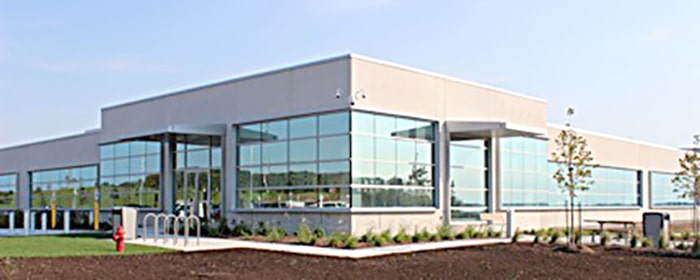IBM’s Canadian Leadership Data Centre (CLDC)
Barrie, Ontario
May 30, 2014
- Rating System/Standard
- LEED v1
- Certification Level
- Gold
- Building Type
- Data Centers
Data centres focused on conserving energy are increasingly important as the expansion of technology drives the demand for new infrastructure. With technology running around-the-clock and potentially using up to 75 per cent of the building’s total energy load, the potential for negative environmental impacts can be high. This means that a green data centre focuses a lot on energy savings, and mitigating energy load during peak hours.
The following case study about IBM’s Canadian Leadership Data Centre in Barrie was written using responses previously provided for a LEED Spotlight in June 2014.
Data Centres can be green too
Many companies are beginning to see green buildings as a means of partially addressing this energy challenge. Case in point: the IBM Canadian Leadership Data Centre (CLDC) project, located in Barrie, Ontario, is the first LEED building for IBM Canada, one of North America’s largest technology companies. This one-story mission-critical facility was completed in 2012 and certified LEED Gold NC in May of 2014.
The building consists of the ground floor lobby space, office space, mechanical support space and engineering shops, as well as the first phase of the 25,000 sq.f data centre also known as the “white floor”.
CLDC was awarded LEED Gold certification with a total of 60 points, which were earned by targeting the traditional points, as well as additional innovation credits for exemplary and innovative performance strategies. As a commercial building, special attention was also focused on improving occupant health and well-being of employees by providing a high level of indoor environmental quality.
The energy saving is in the details
While the project team that worked on the CLDC used some traditional green building approaches in its design and construction, they still had the challenge of creating a much more efficient building that housed energy hogging servers and technology.
According to Luisa Simonin, CB Richard Ellis Limited, who works on the IBM project, by adhering to a solid plan, IBM was able to achieve the desired results.
“We took a two-step approach which included ensuring that all server equipment that was deployed on the raised floor was ENERGY STAR rated, ” she says. “This first step ensured a minimized demand load for the building infrastructure needs.
“Once we ensured that the total estimated load was significantly reduced, we looked at the energy performance of networked equipment and made sure it was optimized throughout the data centre floor. By using an integrated smart server control system that allows the collective devices to “talk to each other”, we had the opportunity to have this equipment share power instead of using individual sources.”
Apart from this unique strategy, there were also underfloor systems installed at the CLDC that bring the air delivery closer to the source to be cooled. This saves a significant amount of energy through one of the simplest methods available, an increase in the allowable temperature set point of the building. Nowadays, buildings spend a majority of their energy rejecting heat from people, equipment, and infrastructure. A higher building set point reduces the running time of energy consuming conditioning systems.
Lastly, high albedo materials were used to cover the majority of the effective roof area to mitigate urban heat island effect by reducing the heat gain through a building’s envelope.
This resulted in a 20 per cent reduction in energy demand – an exceptional achievement for a facility of this type.
Occupant health was also a priority
IBM’s employees in the CLDC enjoy a high level of indoor environmental quality because the building was designed using LEED as a guide for improving occupant health and the well-being of employees. This was accomplished by providing an environment with low Volatile Organic Chemicals (VOCs) both during the construction phase, and during current operations. Good air quality is maintained by green housekeeping policies and increased ventilation which make for a healthier workplace.
Additional project strategies and results
- 51.33 per cent of materials were sourced and provided regionally with high recycled content (e.g. workstation furniture from Teknion), reducing the need for virgin materials and carbon footprint resulting from transportation, and all wood-based products that were specified and installed have an FSC content of 100 per cent.
- Nearly two-thirds of the site (excluding the building footprint) was restored, promoting biodiversity by protecting existing environments in which species native to the region can thrive. The large expanse of vegetated open space aligned with this strategy as well as it continues to provide adequate space for the stormwater retention pond which has been designed to an Enhanced Level of Protection with 80 per cent long-term removal of total suspended solids as required by the Ministry of the Environment. Allowing stormwater to permeate the ground is the best way to allow the natural filtration process to occur as intended.
- Construction waste management plan that diverted 83.4 per cent of waste from landfills.
Most energy reduction strategies focus on building infrastructure as the primary load, but IBM Canada’s CLDC was able to prove that even non-traditional buildings can be greener on energy and greener for occupants, while still maintaining a high level of quality service.

LEED SCORE CARD
| Certification Level | Gold |
| Rating System | LEED Canada for New Construction and Major Renovations 1.0 |
| Total Points earned | 60 |
| Sustainable Sites | 15 out of 26 |
| Water Efficiency | 10 out of 10 |
| Energy & Atmosphere | 12 out of 35 |
| Materials & Resources | 7 out of 14 |
| Indoor Environmental Quality | 8 out of 15 |
| Innovation | 5 out of 6 |
| Regional Priority | 3 out of 4 |
